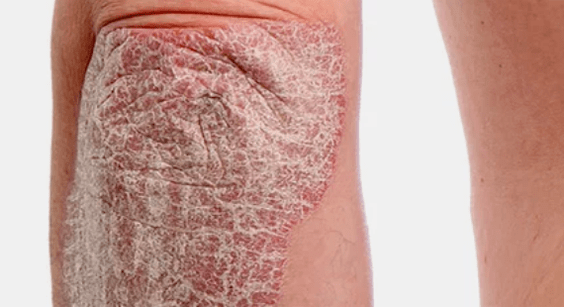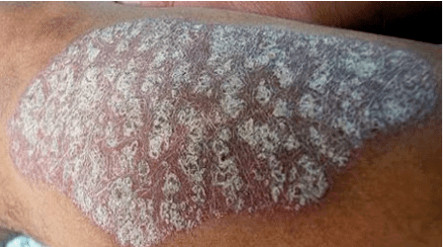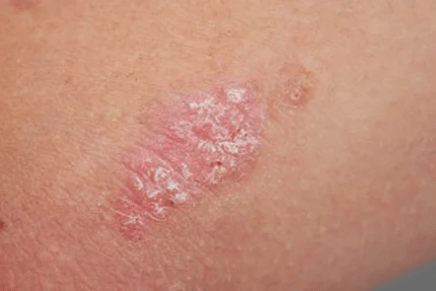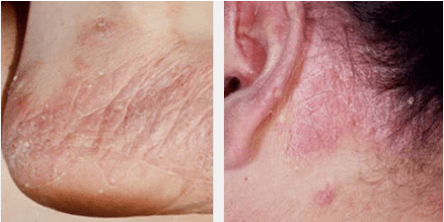Psoriasis is a painful disease, painful and physically and morally.Despite the fact that it is not contagious, many people try to avoid communicating with patients.Psoriasis contributes to the development of depression, isolation.A person does not visit beaches and pools, he has problems in personal and intimate life.
What is psoriasis?
Psoriasis is an non -strut, chronic skin disease (dermatosis) with impaired keratinization processes and inflammation.In the scientific language, the basis of psoriasis is:

- Hyperproliferation in the epidermis, or excessive reproduction of cells;
- Violation in the work of keratinocytes;
- The occurrence of inflammatory infiltrate in the dermis.
Speaking of a chronic character, it must be emphasized that if a young man has a tiny plaque and soon disappeared - this means that after 20 years he can again see new plaques on himself.
The causes of psoriasis
The incidence of psoriasis is very high: even in successful countries of Western Europe, it occurs in 2% of the population.The disease can begin at any age, but debut more often occurs in young years, and only in 1/3 of patients it occurs after 40 years.
It is believed that the presence of relatives with psoriasis significantly increases the risk of its appearance, and there is an autosomal -dominant type of transmission of a genetic defect (that is, not associated with sex).But, most often, the causes of psoriasis lie in the influence of a number of adverse factors that contribute to the restructuring of the body.
We list the most important of the causes of psoriasis:
- Chronic stress, emotional strain, adverse social climate;
- Microbial and viral infections prone to the chronic course (for example, streptococcal infection or herpetic);
- Direct physical effect on the skin (excess friction, pressure, frequent insolation);
- Skin injuries.In the event that plaques arose at the site of the injury, then this is called Kebner's phenomenon;
- Hormonal imbalance.Psoriasis often occurs when entering the puberty, and less often in menopause.This is due to the influence of the thyroid gland, as well as the hormones of the adrenal cortex;
- Taking some drugs.Such a “psorogenic” action was observed in lithium salts used in psychiatry, in ACE inhibitors, some beta - adrenector, in the antimalarial agent of chlorochine;
- Alcohol, especially beer.Contributes to both the most severe course of the disease and elementary, its beginning;
- Obesity, or excess body weight.There are undeniable facts that indicate that people who brought their weight normal after a long -term excess have practically disappeared psoriasis and even psoriatic arthritis;
- Climate factors.Psoriasis takes place in seaside, warm, solar climate.But the continental, humid and cold climate can contribute to both the beginning and the progression of the disease;
- HIV - infection.This disease contributes to the appearance of a variety of diseases that “use” the defect of the immunity system, and psoriasis is no exception.
What happens in the skin, or pathogenesis of psoriasis
The “unit” of psoriasis is a skin plaque, in which immune inflammation flows, as well as in the joints with psoriatic arthritis.
In plaques, many substances were found, for example, analogues of leukotrienes that attract leukocytes to the focus of inflammation.As a result of the interaction of keratinocytes with immunocompetent cells, an inflammation zone arises, with the release of inflammation mediators.
Various inflammatory changes arise in the skin, leading to the occurrence of an extremely characteristic, and even pathognomonic signs for psoriasis: stearin spot, terminal film and bloody dew.
- With a slight propagation of plaques (for example, a fingernail), a characteristic crushing and exfoliation of scales arise.This is very reminiscent of a drop of a drop of Starin, or paraffin, which fell from a candle;
- Under some conditions (for example, after a shower, on already dried skin) you can raise the edge of the scales, and remove it in the form of a grayish-yellow, translucent, like parchment, of a thin film that sometimes reaches an area of 3-4 square meters.cm - symptom of the terminal film;
- If at the site of the film filmed more, then the appearance of small drops of blood, similar to dew, which is called, is called blood.
This can lead to the fact that with skin itching at night, the patient shakes off the mass of dead scales from the sheet, resembling a mixture of flour with bran, and blood droplets can be baked on the sheets.This symptoms are characteristic of the exacerbation stage.
Psoriasis - initial stage
With psoriasis, plaques affect all skin layers.With psoriasis of the initial stage, the plaque after complete development does not differ in its main features from ordinary plaques, but in the beginning it has the following characteristic features:
- It occurs on the surface of unchanged skin a flat tubercle, in a diameter of 1-3 mm;
- its boundaries are clear;
- Color - saturated, red or pink, sometimes bluish, especially with psoriasis on the legs;
- The surface becomes loose, the layers of scales that have a silver-white shade are formed;
- Plains merge, as a result, large rashes arise, with festone, “polycyclic” contours.
Where are the rashes localized?
Symptoms of the initial stage of psoriasis can be seen in the "favorite places."These include:
- Extensor surfaces of the elbow and knee joints (sometimes - the back, this is called “reverse psoriasis”);
- Sacrum;
- The hairy part of the head.Raising your hair, you can see along the edge of the red rim of the skin during exacerbation, slightly protruding behind the hair growth line: “psoriatic crown”;
- Psoriasis "loves" to settle at the ears, next to the growth of hair, and inside the ear shells;
- Large skin folds are amazed somewhat less often.
Psoriasis on the nails of the legs and arms
Nails for psoriasis are affected in almost 50% of patients.Pits and spots appear on them, and the nails resemble the upper part of the eel.
Also, their free edge grows poorly, it becomes yellowish and brittle, which can cause suspicion of a fungal disease.The body of the nail itself changes the color, it appears on it as transparent areas, which are called "oil".
Most often, damage to the nails suggests that the patient has psoriatic arthritis, or there is a tendency to his development.
Not all nails can be affected by psoriasis, but only on the legs or arms.
Stages of psoriasis - exacerbation, stability and regression
All troubles and grief falls on the progression of the disease when symptoms are aggravated.In each patient, an exacerbation is individual.Sometimes exacerbation occurs in response to “good deeds”.
For example, the patient smoked for several years.Having decided that smoking harmfully affects the course of psoriasis (and fairly), he throws, but a month later adds 5-8 kg.As a result, he receives a significant exacerbation, which arose to gain weight and “ignored” the fact of a successful struggle against smoking.

Exacerbation
Despite the "special path", there are some common features:
- Exacerbation appears after a cold, tonsillitis, stress, binge;
- The appearance of new spots arises;
- The peripheral region expands on old spots, the spots “grow”;
- The layer of scales thickens;
- Skin itching is enhanced.In the room where the patient lives with psoriasis, it is better to put a light laminate and linoleum, since they are less noticeable skin scales that appear in large numbers after itching plaques;
- In severe forms - there is an increase in joint pain, a general malaise appears;
- The progressive stage is characterized by the phenomenon of Kebner.Any skin injury turns into new plaques.
Stable state
A decrease in signs of exacerbation of psoriasis - plaques do not change, there is no particular itching.The “husks” from the patient are pouring a little.
Growth stops on plaques, redness is replaced by pallor and a “pseudo -active” rim is formed, which can disappear and an exacerbation will again occur.
Regression
Most often, the improvement in the condition begins with the center of the plaque.There begins the disappearance of scales, a new skin appears.The peripheral growth zone remains pale and inactive, as a result there are “garlands” from the rings and all kinds of bizarre spots.If the rashes completely disappeared, then often at this place there is a area of the skin with reduced pigmentation.
Very often, the regression of psoriatic rashes develops in the summer when the patient is in the sun.Exacerbations, on the contrary, occur in spring and autumn, when the skin experiences a deficit in sunlight.
- With incomplete regression of rashes, the “duty plaques” most often remain, which are localized in the elbows and on the knees.
Types of psoriasis, features on the skin
Conventional, skin psoriasis has several types: seborrheic, exudative, psoriasis of the skin folds, as well as palms and soles.Nail psoriasis, as a rule, does not occur separately.
- The seborrheic form is very similar to the dermatitis of the same name.Scales are localized on the scalp, behind the ear, on the chest.The rashes have vague boundaries, they are impregnated with skin lard and have oily, thick and loose scales;
- With exudative psoriasis (which is more common with obesity), the exudate that impregnes scales, slightly changes symptoms.As a result, scales lose their silver tint, glue, become yellowish and resemble crusts;
- With psoriasis of the palms and soles, which is more common in people engaged in physical labor (chronic trauma), sometimes rashes are isolated.Hyperkeratosis often develops, "simulating" corns;
- Psoriasis of the skin folds mainly develops with aggravating pathology, for example, with diabetes.Placers arise around the navel, under the mammary glands, in the perineum and in inguinal folds.
Severe forms of psoriasis
We will briefly get acquainted with the generalized forms of the psoriatic process - this is psoriatic angeroderma, pustular psoriasis and arthritis.
- Psoriatic erythroderma is nothing more than the progressive stage of psoriasis, exciting the entire skin.
The skin becomes edematous, hot, the total temperature rises to high numbers, then the skin is covered with scales.Against the background of the general erythroderma, you can no longer distinguish the drawing of previous psoriasis: everything merges into one general inflammation.This condition can provoke electrolyte disorders and heart failure.
- With pustular psoriasis, the appearance of pustules, or abscesses, is characteristic.
These abscesses are initially sterile and consist of neutrophils, but then can be infected.The course of the disease is also severe, with signs of inflammation, burning and soreness on the skin, a general reaction, a change in blood, an increase in ESR.Pustules merge, and purulent "lakes" arise.Pustulas are at different stages of development, and severe complications (kidney and heart damage) can also develop.
- Psoriatic arthritis can manifest itself in morning stiffness and pain, more often in the hands and feet.

As a rule, skin lesions arise first, and then joints are affected.Ileosaral joints, spine, and temporal joint joints are also affected.
The involvement of the joints of the axial skeleton indicates an unfavorable course of the disease.In severe cases, the final phalanges are completely destroyed and the muppisle of psoriasis occurs.
Treatment of psoriasis - drugs, ointments and methods of therapy
It should be firmly remembered: a complete cure of psoriasis is impossible, and there is no universal medicine for psoriasis.But you can achieve a persistent lifelong remission, normal well -being, and a complete absence of plaques.
The treatment of psoriasis is stepped - at first, especially with limited forms, they use non -valley methods.With ineffectiveness, local drugs and ointments are connected, then - drugs for oral administration and for parenteral use.In severe cases (for arthritis, erythroderma), “heavy artillery” is used - cytostatics and monoclonal antibodies.
NELARARICS Therapy
Sometimes a complete refusal of drinking alcohol and smoking, normalization of body weight and a calm, “joyful” lifestyle + diet, aimed at excluding spicy, spicy and irritating food, completely cleanses the skin of a person.
There are no diet rules, but many note that psoriasis is best succumbing to the “Mediterranean” diet, with the presence of vegetables, fruits, olive oil, fish, low-fat meat.
- But more often, nevertheless, the periodic use of funds for local use is required.
Basic therapy
In the event that the treatment of psoriasis with ointments and local drugs does not lead to regression, then the treatment of psoriasis is used with combinations of drugs:
- Prescribe infusion of calcium gluconate, sodium thiosulfate with desensitizing and anti -inflammatory purposes;
- Use the esters of fumaric acid inhibiting the transmission of "signals" about inflammation;
- The cytostatics has an antiperibratic effect, blocking the synthesis of nucleic acids.It is taken in the form of tablets once a week, always with folic acid.
It is indicated for rheumatic disorders, including psoriatic arthritis, and is used for long -term therapy.It has many side effects, so the doctor must control the treatment.

- Artificial derivatives of vitamin "A", or retinoids.Suppresses rapid cell growth, is used in severe forms of the disease;
- Monoclonal antibodies, and chimerous protein complexes blocking FNO - alpha.This is a fairly expensive type of therapy, since the drugs are obtained by genetic and molecular engineering, and their acquisition is not “pocket” to everyone.But they provide A pronounced positive action In severe forms of the disease and especially psoriatic arthritis.
Also very important in the treatment of all forms of psoriasis without exception can be called thalassotherapy (treatment with sea), balneotherapy, climatotherapy.
The prognosis of the treatment of psoriasis
In the event that a person adheres to recommendations for organizing a healthy lifestyle, then any psoriasis, at least, does not progress, even the most severe.But it is worth changing the rhythm of life a little - getting better by 5 kg, start drinking alcohol, change the place of residence for cold and rainy - and the disease will “twist you” in the next exacerbation.
No one can definitely say in advance whether the severe, generalized forms of psoriasis will develop or not, therefore, in any case, it is necessary to consider your disease as a potentially dangerous one.
The same patients who have already been diagnosed with psoriatic arthritis need to urgently “return” to the indicators of body weight that you had before the first signs of psoriasis, and throw bad habits.
- In conclusion, it must be said that psoriasis, symptoms and principles of treatment of which in adults we examined, could be found five less often, if it were not for the “bustle” rhythm of the life of a modern metropolis, hypodynamia and an unfavorable environmental situation.

















